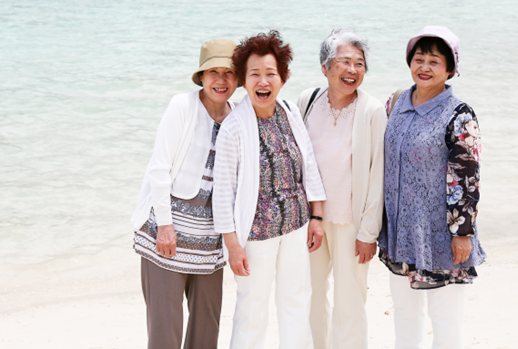By Louise Addison
As a nation we’re obsessed with ageing. We try to turn the clock back with lotions, potions and sometimes Botox and fillers.
Yet some nations seem to have solved this issue without resorting to cosmetics or surgery. These people live in the world’s so-called Blue Zones. The term ‘Blue Zones’ refers to geographic areas in which people have low rates of chronic disease including heart disease, diabetes, dementia, and several types of cancer, and enjoy life spans more than a decade longer than people elsewhere in the world. The concept of Blue Zones grew out of the work done by researchers Gianni Pes and Michel Poulain. The five Blue Zones are: Ikaria in Greece, Okinawa in Japan, The Ogliastra Region in Sardinia, Loma Linda in California (which boasts the highest concentration of Seventh Day Adventists in the US), and the Nicoya Peninsula in Costa Rica.
Dan Buettner, who is an author, explorer, educator, and endurance cyclist, studied these regions intensively and concluded that the inhabitants all shared certain characteristics.
They exercise – but not at the gym, and they don’t run. Instead, they live in environments that encourage movement. They walk, garden, and tend to use manual tools rather than electric ones, when working in the house and garden.
They live with purpose – The Okinawans call it ikigai and the Nicoyans call it plan de vida; both roughly translate to “why I wake up in the morning.” A sense of purpose adds several years to your life span.
They take time out – Everyone, even those living in Blue Zones experience stress. Stress is the leading cause of chronic inflammation and is associated with every major age-related disease. The Blue Zone populations understand how to deal with and diffuse that stress. Okinawans take a few moments each day to remember their ancestors, Adventists pray, Ikarians take a nap, and Sardinians do happy hour!
They follow the 80% rule – The Okinawan’s have a 2,500-year-old Confucian mantra, ‘Hara hachi bu’, which they recite before meals. It reminds them to stop eating when their stomachs are 80% full. The 20% gap between not being hungry and feeling full could be the difference between losing weight and gaining it. People in the Blue Zones eat their smallest meal in the early evening, and then they don’t eat any more for the rest of the day.
They eat a plant-based diet -The people of the Blue Zones eat mainly plants and beans, limiting meat to small portions a few times per month.
They drink moderately – Apart from the Adventists, all the people living in the Blue Zones drink alcohol regularly. Moderate drinkers actually outlive non-drinkers. So, keep to one to two glasses a day, preferably drunk with a meal and with friends or family
They have a community – The world’s longest-lived people chose – or were born into – social circles that support healthy behaviours. For example, Okinawans created moais – groups of five friends that committed to each other for life. Research shows that smoking, obesity, happiness, and even loneliness are contagious, so healthy social networks are essential for long life.
So, if you are interested in living a longer, and healthier life…think blue!

